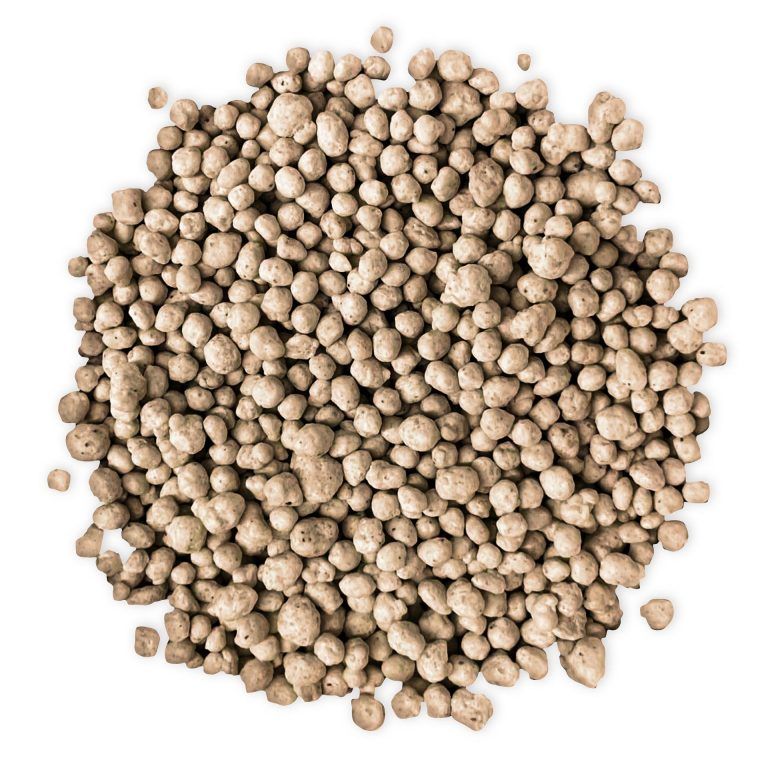
Technical specification
NPК 16:16:8 + 12 S inorganic complex fertilizer is a product obtained chemically by neutralization of extraction phosphoric acid with ammonia, addition of potassium chloride and subsequent granulation of the product. The complex fertilizer can be applied in the pre-sowing or in-sowing period and as the main fertilization of wheat, barley, oats, rye, rape, sunflower, corn, etc.
Nitrogen available as ammonia nitrogen plays an important role in the processes of plant growth, development and fruiting. As a constituent of the chlorophyll molecule, nitrogen plays a key role in the process of photosynthesis, in the formation of foliage and in fruit and seed production. Soils with a neutral pH reaction favor the uptake of nitrogen in the form of ammonium nitrogen (NH4) and lead to a decrease in soil acidity. Conversely, acid soils favor the uptake of nitrate ions (NO3).
Phosphorus as an element stimulates the growth of the root system in depth, which has a beneficial effect on the drought resistance of plants and accelerates crop development. It increases plant resistance to diseases and pests, as well as cold hardiness, which is mainly due to:
- Increased soluble carbohydrate content in cell sap;
- Lowering the freezing point of plants.
Potassium in the product is represented in the form of potassium chloride. In most cereals, potassium is absorbed most intensively during tillering and flowering, and in corn – after 7–8 leaf formation and booting.
The balanced content of NPK 16:16:8 + 12 S helps to fully satisfy the needs of plants at every stage of their vegetative development. The sulfur content of the product is of key importance, as sulfur deficiency results in the cessation of cambium activity, reduces leaf chlorophyll content and stunts plant growth.
Advantages
- A return to the principles of balanced fertilisation – maximising the efficiency of fertiliser inputs while ensuring that plants are fully nourished with all nutrients;
- Overcoming the adverse effect on soil and crops of one-sided nitrogen fertiliser application;
- Lower costs for soil application /once/, transport, time and labour savings;
- Ability to apply relatively low rates of a given element, which is difficult to achieve with split fertilization;
- Increase in crop production quality and yields.
Technical characteristics
It satisfies the requirements of Regulation 2003/2003 relating to mineral fertilizers with high contents of nitrogen.
| PARAMETER | NORM | HARMONIZED ANALYTICAL STANDARDS |
|---|---|---|
| Total Nitrogen (N), % | 16.0 ± 1.9 | BDS EN 15750 |
| Ammoniacal Nitrogen, % | 16.0 ± 1.9 | BDS EN 15475 |
| Total Phosphorus pentaoxide (Р₂О₅), % | 16.0 ± 1.9 | BDS EN 15956; BDS EN 15959 |
| Phosphorous pentaoxide (Р₂О₅), soluble in neutral ammonium citrate, % | 15.0 ± 1.9 | BDS EN 15957; BDS EN 15959 |
| Phosphorous pentaoxide (Р₂О₅), soluble in water, % | 13.0 ± 1.9 | BDS EN 15958; BDS EN 15959 |
| Content of Water* | max 2.0 | BDS EN 13466-1 |
| Potassium (as K₂O), soluble in water, % | 8.0 ± 1.9 | BDS EN 15477 |
| Total Sulphur (S), % | 12.0-0.8/+1.6 | BDS EN 15960; BDS EN 15749 |
| Cadmium (Cd)*, mg/kg P₂O₅ | max 60 | BDS EN 16319 + А1 |
| Hexavalent Chromium (Cr VI)*, mg/kg dry matter | max 2.0 | BDS EN 16318 + А1 |
| Mercury (Hg)*, mg/kg dry matter | max 1 | BDS EN 16320 + А1 |
| Nickel (Ni)*, mg/kg dry matter | max 100 | BDS EN 16319 + А1 |
| Lead (Pb)*, mg/kg dry matter | max 120 | BDS EN 16319 + А1 |
| Arsenic (As)*, mg/kg dry matter | max 40 | BDS EN 16317 + А1 |
| Granulometry: granules 1-5 mm | min 98 | BDS EN 1235 |
Crops

Barley

Rapeseed

Sugar beet

Oats

Wheat

Sunflower

Soybeans

Silage corn

Potatoes

Perennial grasses

Corn

